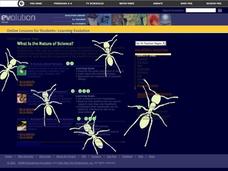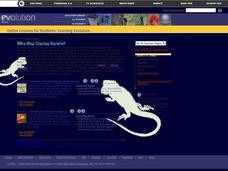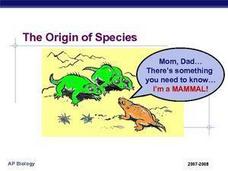Curated OER
Frederick Law Olmsted
Students explore life in New York and the creation of Central Park. After reading a picture book about Frederick Law Olmstead, they discuss the expectations and evolution of New York's Central Park. Next, students describe a park near...
Curated OER
Decorating Objects... and Re-decorating
Students create decorative objects and discuss their importance in form and function. In this art history instructional activity, students discuss Chinese porcelain objects with mounts later added by the Chinese. Students recreate an...
Curated OER
AP Biology Demonstrations
Young scholars explore difficult-to-understand topics in biology. In this biology lesson, students participate in a series of demonstration on genetics, evolution and many others to gain insight on these topics. They write a report after...
Curated OER
Brine Date
Have you been wondering what to do with that aquarium full of brine shrimp? This activity has teens sea monkeying around with measurement, observations, and hypothesizing about the mating behaviors of these little critters. If you do not...
Curated OER
Global Awareness
High schoolers read about how scientists are arriving at current theories of human origin and migration through mitochondrial DNA analysis. They then piece together a map showing the data from mitochondrial DNA analysis to plot the...
Curated OER
Street Language
Learners consider the impact of language. In this literacy lesson plan, students read an article about literary classics being rewritten in "youth speak" (the article is not included). Learners read and discuss the article.
Curated OER
Who Was Charles Darwin?
Students examine how Darwin used the processes of science to support his theory. They distinguish between artificial and natural selection, recognize Darwin's contribution to science. They produce a newspaper describing the times in...
Curated OER
What is the Nature of Science?
Students examine videos of field researach to discover the components of the scientific process. Using forms, they conduct community surveys about the nature of science. They research the extinction of dinosaurs and compare...
Curated OER
Ancient Farmers of the Amazon
High schoolers read a sample research proposal and create their own. They discover the type of information needed for others to reject or accept the proposal. They practice applying the scientific process to different situations.
Curated OER
Who Was Charles Darwin?
High schoolers complete two activities to study Charles Darwin's Theory of Natural Selection. They read Darwin's journal from the voyage of the Beagle and look at the scientific ideas that influenced the development of his theory.
Curated OER
How Did Humans Evolve?
Learners are introduced to four important fossil finds: the First Family, the Hadar Skull, Lucy, and the Laetoli Footprints. They explore how scientists interpret fossils to try to better comprehend how humans evolved. This activity...
Curated OER
Origin of The Species
After viewing information about different types of isolation, students will see that reproduction among a group will cause the frequency of a specific trait to increase. The history of prominent scientists such as Charles Darwin are and...
Curated OER
Hardy-Weinberg Lab Data
The ten slides give multiple examples of Genetic Drift, or cases of particular genetic populations. Each set of data requires an explanation and the allele frequency changes should be easy for your students to calculate.
Curated OER
A Simple Model for Natural Selection
Do you have what it takes to survive as a fit predator or will elusive prey lead to your extinction? Find out in a creative natural selection activity. Using different colors and shapes of grains to represent different species and...
Next Generation Science Storylines
Why Don't Antibiotics Work Like They Used To?
Bacteria get more resistant to antibiotics every year. Learn the reason for this pattern and how scientists are addressing the problem in a six-week unit. Learners analyze different types of bacteria and their adaptations.
Curated OER
How Do New Species Form?
Students read an article by Niles Eldridge about species and the environment and break into small groups to discuss it. They write essays noting strengths and weaknesses of punctuated equilibrium and gradualism, or other topics listed.
Curated OER
Microbes: Too Smart for Antibiotics?
Students examine how germs spread from one person or object to another. They discuss antibiotic resistant bacteris and examine the benefits of microorganisms. They explore methods of curbing antibiotic resistance.
Curated OER
What Is the Nature of Science?
Students distinguish between scientific and everyday meanings of key words-theory, hypothesis, law, fact-and use in context. They recognize the variables that affect observation, data collection, and interpretation. They discover the...
Curated OER
Circulatory Systems
Excellent diagrams, labels and summaries make this resource be valuable to your students throughout the topic of circulation. All types of circulation vessels are explained, their structure and function is detailed, and the overall...
Curated OER
Circulatory Systems
A slideshow that covers the all-important details related to basic human circulation. The reasoning for exchange of material methods is presented and then labeled diagrams of the main human transfer systems are shown, along with...
Curated OER
Darwin’s Bees
What do you call a bee born in May? A maybe! This first instructional activity in a series of four begins with a starter activity to get scholars thinking about the topic. Then a circus, or circuit of seven activities, show Darwin's...
Curated OER
Natural Selection of Strawfish
A sequence of pictures accompany a few statements that help define the differences between phenotype and genotype. The slides must be used to accompany a lecture as they do not really explain any concepts. The 5th slide is the most...
Curated OER
Give Me Liberty or Give Me Freedom
Welcome to America, the land of liberty and freedom. Examine the ways in which the terms liberty and freedom have been used in the United States. After researching and analyzing quotations from the past and present, students create an...
Curated OER
A Comparison of Cloud Coverage Over Africa
Students use a NASA satellite data to contrast amounts of cloud coverage over different climate regions in Africa. They explore how Earth's major air circulations affect global weather patterns, and relate to local weather patterns.
Other popular searches
- Human Evolution
- Evolution Worksheet
- Theory of Evolution
- Evolution of Transportation
- Fossils and Evolution
- Adaptation and Evolution
- Evidence of Evolution
- Evidence for Evolution
- Evolution Charles Darwin
- Dog Evolution
- Biological Evolution
- Evolutionary Theorists

























